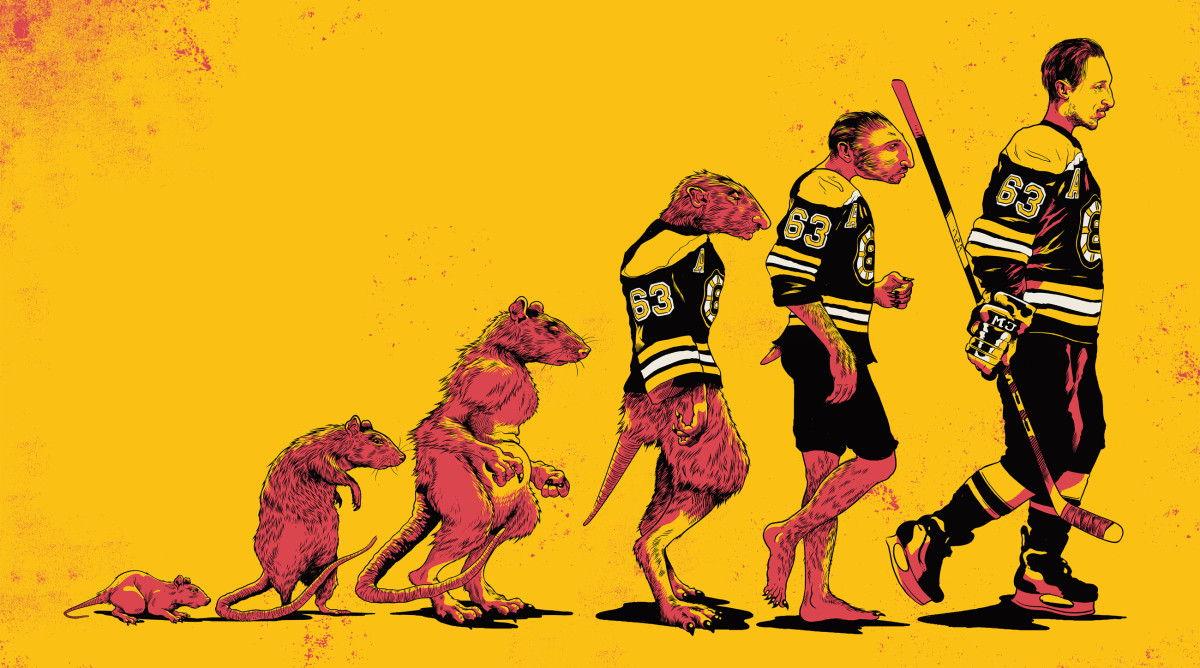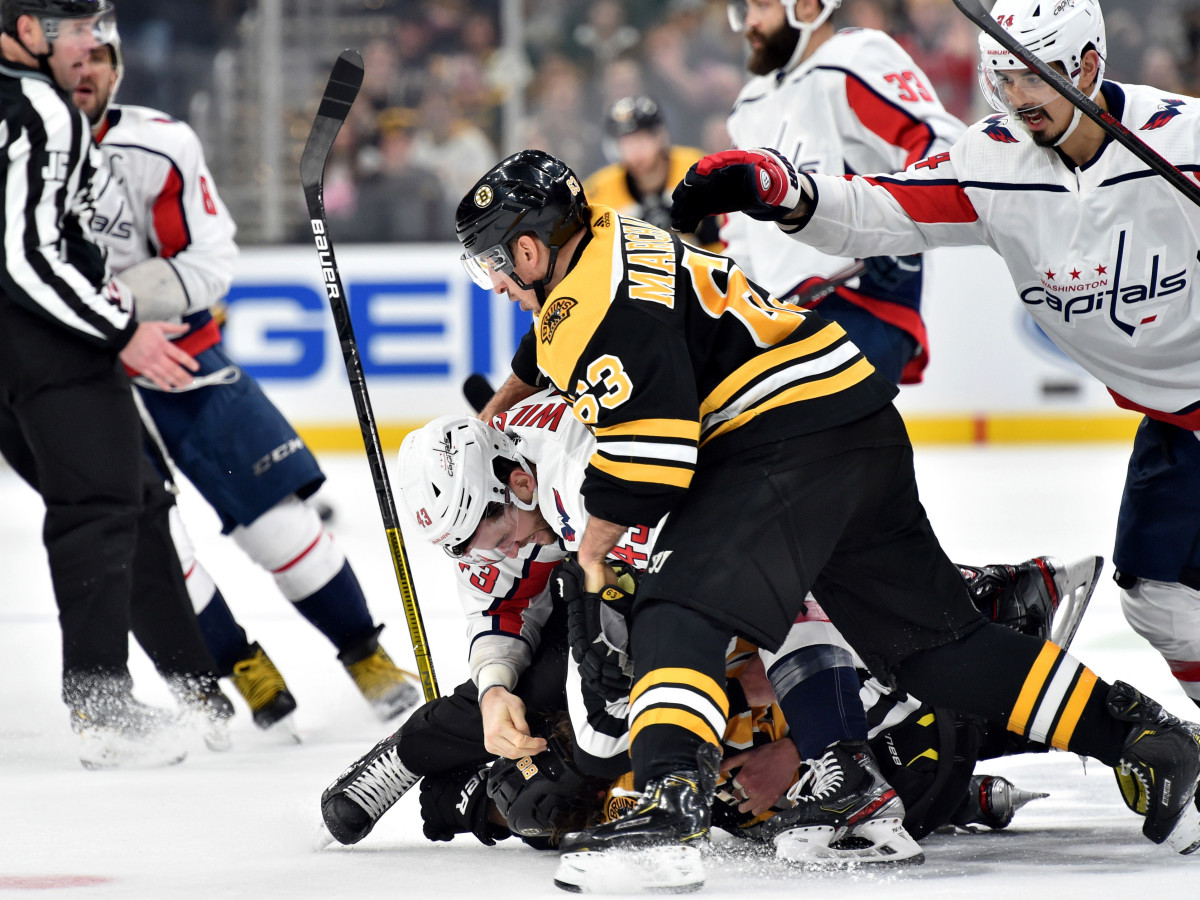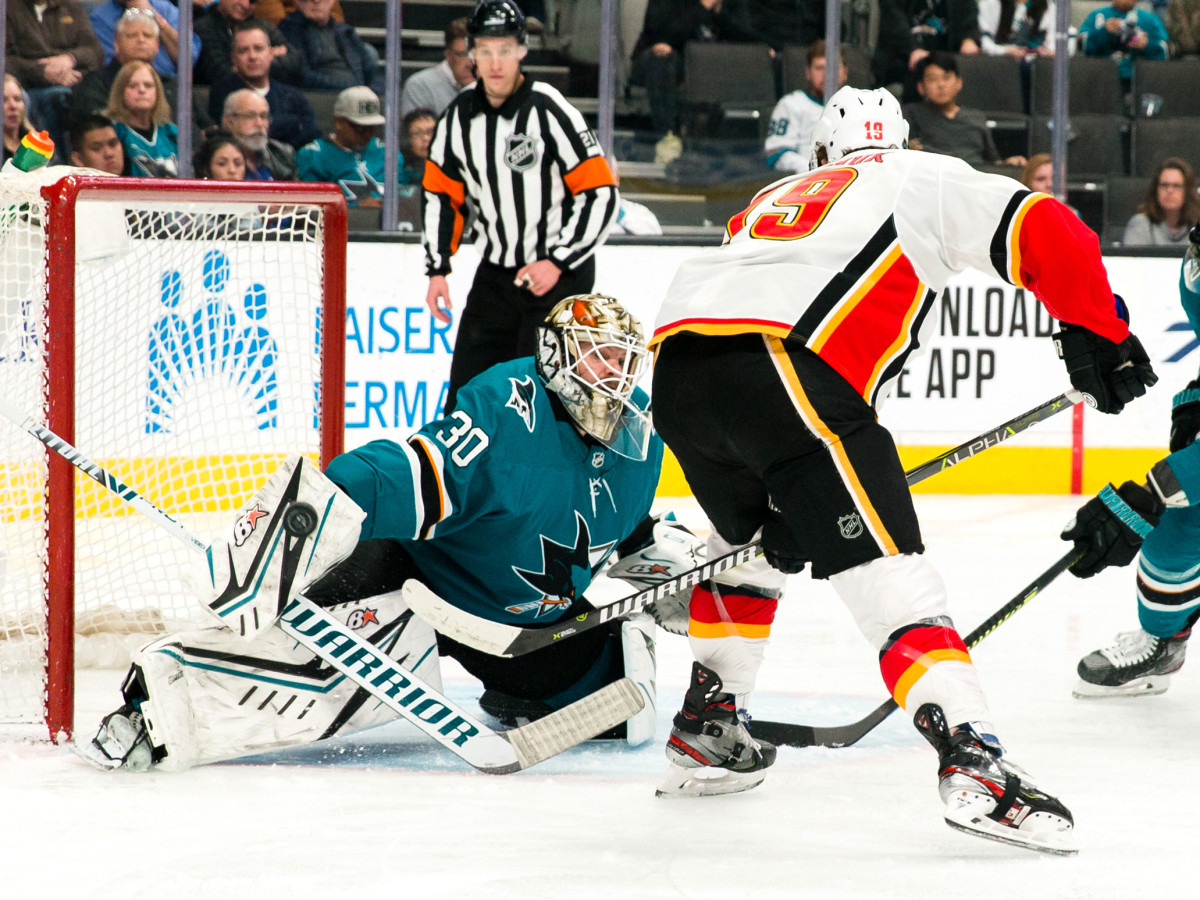The Rise of the Superpest: How Skillful Agitators Prove Invaluable in the NHL Playoffs
Thanks to their high-altitude habitats and powerful sense of smell, the wilderness elk of southern Colorado can be especially challenging quarries for big-game bowhunters. But even they are no match for the persistence of Brad Marchand.
The Bruins winger will devour articles about their feeding, sleeping and migratory patterns. He’ll plot daily predawn routes up the Rocky Mountains using topographic maps and the terrain feature on Google Earth. Once, he called a wildlife biologist and “tried to pick their brain.” Another time he drenched himself and his hunting party in elk urine spray. “It was supposed to draw them closer, but they smell you regardless,” Marchand laments. “Bit of a farce.”
Seeing the Little Ball of Hate in a little puddle of waste, surely the elk had a good laugh.
Up in the mountains, Marchand adheres to a strict code of ethics, proudly describing himself as a conservationist. On the ice, he gladly accepts more wiggle room. Now 32, Marchand doesn’t literally get under the skin of his NHL opponents in the field-dress-an-elk-and-butcher-its-meat sense that he does every hunting season. But he does have a unique ability to burrow in their heads. In hockey parlance, this means that Marchand is classified among a distinct breed of players classically known as pests.

The problem with that label, though, is that it undersells the full extent of what Marchand and his ilk contribute on the ice. “Annoying great player, maybe, would be the better term,” says Claude Lemieux, a four-time Stanley Cup winner and sensei of the craft. “They’re extremely valuable during the regular season—and even more in the playoffs.” All pests draw attention for trash-talking as much as cross-checking. But the most effective ones put pucks in nets and opponents in penalty boxes with equal efficiency, two especially critical ingredients in the emotional stew of a seven-game series. “They’re very, very rare now,” says Pat Verbeek, 55, the original 5' 9" Little Ball of Hate. “If you can find one, you grab him.”
As the top-line wrecking ball who swung alongside Alex Ovechkin when the Washington Capitals captured the 2018 Cup, winger Tom Wilson qualifies in this category of new-age Superpests. "Teams aren't just going to waste space on a pest now," Wilson says. "You've got to get the job done, or you won't be around." Ditto for the two Tkachuk brothers, Matthew and Brady, bugging skaters north of the border for Calgary and Ottawa. “All of them make plays, go to the net, do the right things on the ice,” Washington GM Brian MacLellan says, “and then they do the extra stuff after, that gets a reaction out of the other team. It’s a skill. It’s a good skill.”
No better modern example exists than Marchand. As a rookie fourth-liner in 2009–10, he averaged fewer than 12 minutes of ice time and next to none on the power play. But he scrapped, yapped and punched (see: Sedin, Daniel) his way to relevance in helping Boston win the 2011 Stanley Cup. “That’s what I had to do to make the NHL,” Marchand says. “That was my role.”
Like any member of a species needing to survive, Marchand evolved. It has been two and a half years since his last suspension (January 2018: five games, elbowing) and almost that long since his last fine (April ’18: $5,000, cross-checking). And this spring marked another anniversary of his most memorable stunt, twice licking opponents during games in the ‘17–18 playoffs. (“It’s not something I was ever told I wasn’t allowed to do,” he said to SI at the time.)
Marchand still visits the sin bin in line with his career average, hovering a little above one penalty minute per game in ‘19–20. But it’s what he does with the rest of his time on the ice that’s changed the most. True to his outdoorsman instincts, he began studying the habits of more skilled players and incorporated their moves into his game. “There’s so much talent in the league,” he says. “There’s a lot to learn.” He watched tape of Hall of Fame center Joe Sakic firing wrist shots from his off-foot; he noted how former Red Wings virtuoso Pavel Datsyuk lifted opposing sticks out of the way before swiping the puck. Seeing the benefits of a wide-based stance employed by Penguins captain Sidney Crosby, a fellow Nova Scotian and occasional training partner, Marchand worked on his skating form below the goal line.
Perhaps it’s fitting, then, that Marchand pinpoints his breakout moment to the 2016 World Cup, when he won gold while skating on Team Canada’s top line alongside Crosby and Bruins teammate Patrice Bergeron. “My confidence skyrocketed,” Marchand says. “I always thought I was a decent player. But after that tournament, when you’re playing against the best, I knew I could be an elite player. It went much better than I ever could’ve expected.”
Back-to-back 85-point seasons followed before Marchand posted a career-high 100 in 2018–19, when his distinctly infuriating effectiveness was showcased throughout the playoffs in two major ways. On the one hand, Marchand’s 23 points (nine goals, 14 assists) helped the Bruins reach Game 7 of the Cup finals, and he averaged more ice time (20:15) than any Boston forward, shouldering top-unit minutes at all three strengths.
On the other, he stomped on and broke Blue Jackets winger Cam Atkinson’s stick before a face-off in the second round; sucker-punched Columbus defenseman Scott Harrington in the back of the head; and baited the reputedly icy calm Justin Williams of the Hurricanes into boiling over during Game 2 of the Eastern Conference finals, a 6–2 Bruins win that Williams later likened to “eat[ing] a poop sandwich.”
It’s all part of the pest’s sworn duty.

***
As a kid in Brantford, Ont., Keith Jones loved pro wrestling, flocking to the nearby Civic Centre whenever Maple Leaf Wrestling—“a low-end circuit that used to run on local cable television,” in his words—rolled through town. In particular, Jones gravitated toward a thick-haired (and thick-headed) character named Gino Carabello, who hailed from Long Island and embodied its most obnoxious stereotypes. “He was the villain, so he never won,” Jones says. “He’d just annoy.”
In the 1990s, Jones embraced a similar heel role at NHL rinks with the Capitals, Avalanche and Flyers. “I watched as many games as I could to find as much irritating material to use against players that I was going to face,” says Jones, now an NBCSN analyst. “If I saw someone make a selfish play that cost his team a game, I’d be sure to bring it up later while we were standing there for a face-off. I would just remind him of what he did, then I’d point at his bench and say, ‘They all know. They all know what you’re about.’”
Of course, Jones wasn’t breaking any new ground. “The process of bothering the opposition has been in the game forever,” he adds. “But the most highly sought-after irritants can also play the game at a high level.”
Among the earliest was 5' 6", 155-pound winger Tony Leswick, who struck the overtime winner for the Red Wings in Game 7 of the 1954 Cup finals against the Canadiens and soon after earned a 3,500-word Macleans profile headlined, THE BIGGEST PEST IN HOCKEY. When an Ottawa Citizen reporter later wondered whether Leswick, deep down, felt any of his “deliberate needling” crossed the line into unsportsmanlike territory, the man teammates called Mighty Mouse squeaked, “That’s one way of looking at it. From my viewpoint, anybody who gets mad at me is plain stupid.”
Then there was Ken Linseman, who averaged nearly a point per game over a 14-year career and rode shotgun alongside Mark Messier when the Oilers captured the 1984 Cup—yet might be more famous for getting a tattoo of the nickname that he earned as a result of constantly pestering opponents. “I went into it planning to get a pair of dangling hockey skates,” says Linseman, “and ended up with this pretty s----- looking rat on my calf.”
And Esa Tikkanen, Wayne Gretzky’s longtime Edmonton teammate who earned a true foil’s title, the Grate One. “I remember him kissing me,” Jones says, referencing a ’94 playoff battle between Jones’s Capitals and the Rangers, in which Tikkanen attempted to disarm him with some post-whistle smooches. “He was one of the pests that I appreciated the most.”
The 1980s and ’90s marked a golden age for the role, filled with hooking and holding and unpenalized obstruction galore. But that era has passed. Whistles and fines for embellishment have curtailed diving, once a staple of the agitator’s toolbox. Hulking enforcers have also gone extinct, with fighting not far behind. “It used to be you had a smaller guy with two or three heavyweights protecting him,” says MacLellan. “Now you don’t have fourth-line pests. They’re high-level players.”
Look no further than a top-10 list of penalties drawn over the past three seasons, ending when the NHL suspended its season due to the coronavirus in mid-March. Speedster superstars populate the bottom portion, understandable given how hard they are to slow down with the puck: the Islanders’ Mathew Barzal (99), the Oilers’ Connor McDavid (95), and the Avalanche’s Nathan MacKinnon (95). But a trio is clustered together above the rest: Marchand in third (108), Wilson in first (112), two ahead of the torch-bearer for the next generation.
As Wilson says, “There hasn’t been one in the last five years or so—a young guy that’s skilled, scoring goals, and is a pest. Except for Tkachuk.”
***

On a Monday night in mid-January, Keith and Chantal Tkachuk traveled from their suburban St. Louis home to Montreal, where their son Matthew was visiting with the Flames, and slipped into their seats near center ice. As pregame warmups ended, the Bell Centre announcer began listing Calgary’s starting lineup. When Matthew’s name boomed over the loudspeaker, a man, unaware of who was sitting two rows in front, stood up and screamed: “Hey, Tkachuk! You suck!”
Chantal wasn’t amused. As for Keith, who was no stranger to invoking the ire of opposing fans after nearly two decades in the NHL and more than 2,200 penalty minutes? “I was laughing my ass off,” he says. “Matthew actually relishes hearing that stuff. When people are yelling at him, booing at him, that motivates him more. . . . He’s full of piss and vinegar. That’s the bottom line.”
Entering the NHL’s 24-team playoffs, in which the Flames will face Winnipeg in a five-game play-in round, the case for Tkachuk as hockey’s preeminent superpest is strong. He stars in a YouTube video entitled, “12 Minutes of Matthew Tkachuk Pissing People Off As a Rookie,” which has been viewed more than two million times. He single-handedly turned this season’s Battle of Alberta into must-watch national television by running roughshod over Oilers winger Zack Kassian, his newest archnemesis. Last spring Tkachuk’s younger brother, Brady (a second-year winger for Ottawa who also owns a pestilent reputation), gleefully attended Calgary’s first-round series against Colorado in a T-shirt proclaiming cartoon Matthew as THE RAT KING.
Unlike Marchand and Wilson, who began their careers as grinders before assuming greater roles once their skills caught up, Matthew landed as a polished offensive talent, hovering around 50 points as a rookie and sophomore before exploding for 34 goals in 2018–19. That, quite frankly, may be the most irking thing about him. It’s bad enough to get goaded into slashing him, but watching Tkachuk score on the ensuing Flames power play can be downright devastating. “I’ve always found that when I’m producing,” he says, “that’s when guys get the most mad.”
With slick hands and a penchant for flashy stick skills, Tkachuk scored three Goal of the Year candidates in a 15-month stretch—all across-the-body, between-the-legs shots that require multiple slow-motion replays to fully appreciate. Tkachuk hasn’t yet gauged his true impact across a full postseason like Marchand or Wilson; the Flames were swept out of the first round in 2017, missed the playoffs in ’18, and fell in five games last year to the Avs. (It also remains to be seen how, if at all, the ever-present specter of the coronavirus will affect on-ice life for Tkachuk and his like: Less trash talk in the empty arena? Fewer nose-to-nose scrums to keep social distance? Definitely no licking.) But it’s only a matter of time before Tkachuk makes his mark.
“I feel like people focus too much on the pest part,” Brady says. “With Marchand, people think he’s cheap, but when you see how great his hands are, and how he’s on one of the best lines in the NHL [with Bergeron and league-leading goal-scorer David Pastrnak], and his will to win. . . . It’s the same with Matthew. They’re usually the best players when big games are happening.”
Take Feb. 25, when the Flames and Bruins met for the second time in five days. Marchand and Tkachuk shared the ice for only 2:55 at even strength, leaving little room for any superpest-on-superpest action. Still, both excelled. Midway through the second period Marchand chipped a loose puck into space on Boston’s penalty kill, shielded off defenseman Noah Hanifin while skating at full speed and deposited his 27th career shorthanded goal, most among active players. He then celebrated by staring down winger Mikael Backlund, with whom Marchand had been tussling all night.
Tkachuk, meanwhile, finished with a pair of assists and a goal, backhanding a shot off the end boards past goalie Tuukka Rask in the first period, in Calgary’s 5–2 win. Later, heading toward the Bruins goal on a delayed rush, Tkachuk stumbled and bowled into Rask, knocking the net off its moorings and the Finn off his feet. Rask rose quickly and loomed over Tkachuk, as if considering whether to escalate. “Rask can be fiery too,” Sportsnet commentator Cassie Campbell-Pascall remarked on the broadcast, “so you want to get in his kitchen if you can.”
As Tkachuk explains later, Rask was actually checking on him after the spill. “You good?” the goalie asked, before backing off to let Tkachuk skate away. Moments later, during a break in the action, Tkachuk cruised past Rask’s crease and apologized with a whack in the shin pads.
“No big deal there,” Tkachuk says.
Maybe there’s a dash of honey mixed in with that piss and vinegar after all.
